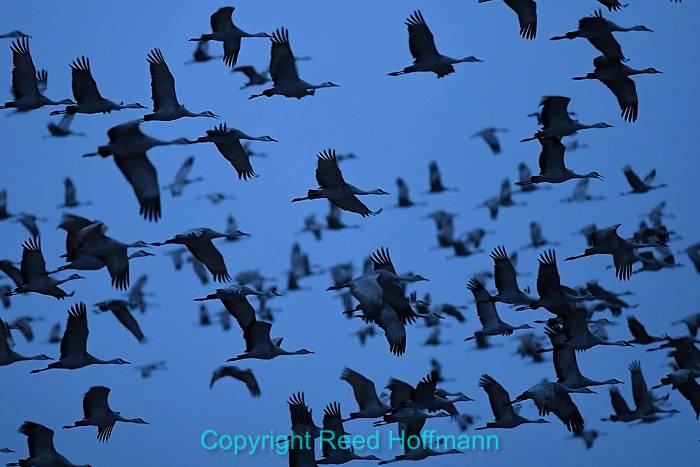I’ll admit it – I’m a fair-weather birder. They’re usually just too darn small and far away to make good pictures. But get me close to some action, and I sing a different tune.
A few years ago an old friend here in Kansas City asked if I was interested in going to see Sandhill Cranes. During their migration north in springtime, tens of thousands of them stop to rest and feed on the Platte River near Kearney, Nebraska. This year Leon and I (joined by his brother and another friend) finally did that as a Nebraska birding photography adventure. It was better than I’d hoped, and part of that was thanks to the Prairie Chickens.
Once common throughout much of the U.S., their territory is now limited to a few small areas in the Midwest, primarily in northern Kansas and southern Nebraska. In the springtime, the males put on a performance that’s quite the show; puffing out air sacs, making thrumming sounds, popping up neck feathers, stamping feet and jumping at each other.
Leon’s research on this led him to Carol Schlegel, Tourism Director of McCook, Nebraska. She runs “Prairie Chicken Dance Tours.” For $100, you get an evening orientation, then a morning outing to a nearby “Lek” where the birds do their thing. “Lek” is a Swedish word that roughly means gathering place, and it’s a small area of short grass where the male birds put on a show. Of course they’re not doing it for us, but for the female Prairie Chickens as a courtship dance.
The morning excursion began before sunrise, at 6am, so we could get to the Lek before the birds become active. There were two horse trailers that had been converted into blinds, with chairs (complete with cushions and blankets), and a counter to rest your camera on. Just as it was getting light enough to see (a little after 7am), the birds started arriving. Unfortunately, because of heavy clouds and light rain, it was still too dark to make good pictures. At 3200 ISO, we were shooting 1/13 second at f/4. I had wanted to use my Nikon D500 to take advantage of the 1.5X “crop” factor with the 500mm lens (giving me the equivalent of 750mm with a full-frame camera). But needing much higher ISO’s, I switched to my Nikon D5. With its larger sensor and larger pixels, I was able to use 40,000 ISO (it’s hard to believe the camera can deliver good images at that high an ISO, but it does). That helped me get my shutter speed up to 1/250 second, which at least gave me a fighting chance at getting some sharp pictures.
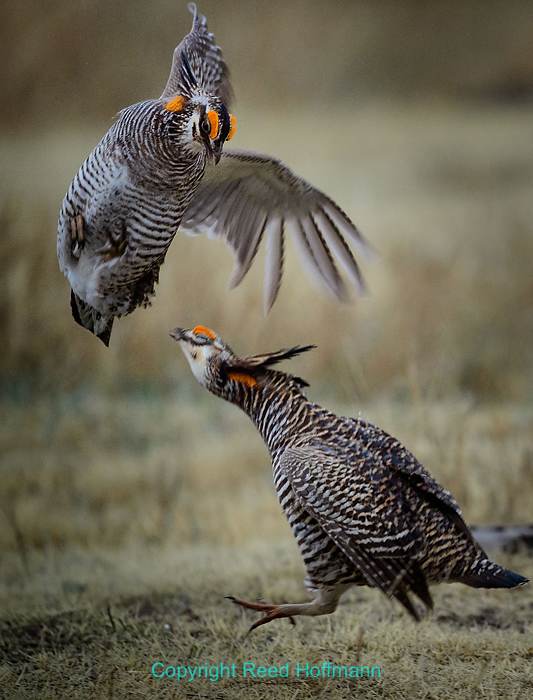
Two male Prairie Chickens competing in the middle of the Lek. You can see that even with 1/500 second, there’s a fair amount of blur in the wing. Nikon D5, ISO 4000, 1/500 at f/4 in Aperture Priority, 0.0 EV, Nikkor 500mm f/4.0 lens at 500mm. Photo copyright Reed Hoffmann.
As the light got brighter, I was able to raise the shutter speed up to 1/500, with the ISO at 25,600. I needed that higher shutter speed because a big part of the courting display is the males jumping at each other in a show of dominance. When shooting action, the minimum shutter speed I try for is 1/500 second. Even then I had too many photos with blur. With that kind of action, I really needed 1/1000 second or faster.
Of course, the dancing portion didn’t need that high a shutter speed. At times they came fairly close (perhaps within fifteen feet), which gave us great opportunities for close-ups. Wildlife photography is usually done with telephoto lenses, and in general, the more lens, the better. Our group had lenses ranging from 300mm to 500mm, and with 1.4X and 2X teleconverters Leon and I were able to extend our reach as far as 750mm and 800mm.
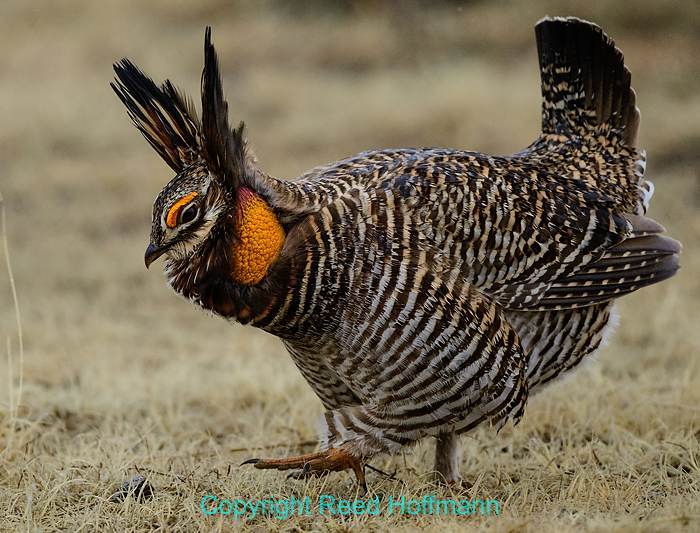
One of the male Prairie Chickens in full courtship mode, putting on an impressive show. Nikon D500, ISO 2000, 1/500 at f/4 in Aperture Priority, 0.0 EV, Nikkor 500mm f/4.0 lens (giving equivalent of 750mm). Photo copyright Reed Hoffmann.
By 9am the birds had finished and disappeared into the taller grasses. Which meant it was time for us to disappear too. We were a bit cold and damp, so it was a real treat to go to Fuller’s Family Restaurant in McCook. Breakfast is included in the package, and Fuller’s didn’t disappoint. In fact, after eating that breakfast, we all skipped lunch.
Once we’d picked up the rest of our gear from the hotel and checked out, we drove east. The next stop on our adventure was the Iain Nicolson Audubon Center at Rowe Sanctuary on the Platte River, outside Kearney, Nebraska. This was where we would photograph Sandhill Cranes. Leon had reserved a blind on the edge of the river for the night for the two of us. We’d be in there by 6pm, and have all of that 8-ft by 6-ft by 4-ft tall unheated space to ourselves. After the staff settles you into the blind, you’re not allowed outside until they come for you the next morning (usually around 9am). You do get you a nice little bucket toilet to help pass the time.
The blind was basic, but clean and dry. There were four windows to shoot out of, two on the sides and two towards the river. The bucket toilet was about the right height for one of us to sit on and use a tripod, but for the next trip I’d probably bring a camp stool or at least kneepads. Without something to sit on, you’ll spend a lot of time on your knees.
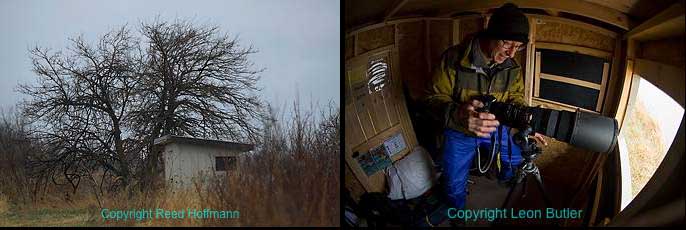
At left is one of the blinds built along the shore of the Platte River. At right, me getting my gear ready, mounting the Nikon D500 and Nikkor 500mm lens on a gimbal mount atop my Gitzo tripod. Photos by Reed Hoffmann and Leon Butler.
We’d both brought good tripods with gimbal mounts. The gimbal allows you to balance a long lens and camera on the tripod, making it easy to swing left and right, up and down. Unfortunately, the rain we’d had for the last day continued, joined by a strong wind. That meant one of the side windows was nearly useless and the two riverside windows also let rain in. Fortunately, the show the cranes put on was worth it.
By 7pm they were flying in from the surrounding cornfields to spend the night on the river. For the next hour they came by the thousands, landing across the river in shallow water. The birds look for an area with about six-inches of water they can stand in to sleep. Doing that helps protect them from predators, as the splashing water would warn the cranes of danger.
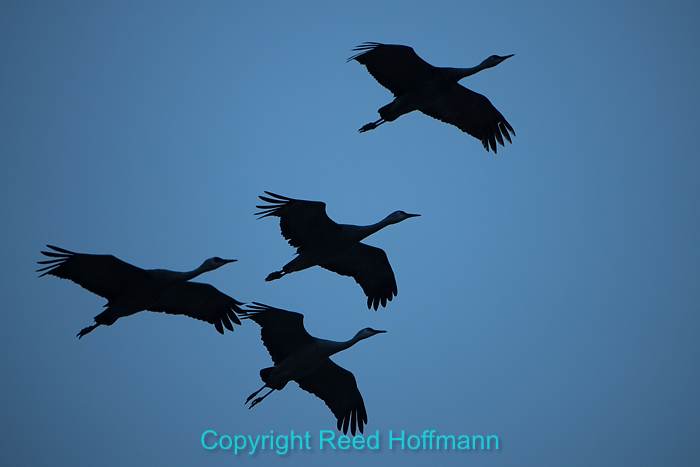
I loved the graphic qualities of the cranes flying across the sky, with those long necks and feather-tipped wings. Nikon D5, ISO 4500, 1/800 at f/5.6 in Aperture Priority, +0.3 EV, Nikkor VR Zoom 80-400mm f/4.5-5.6G lens at 400mm. Photo copyright Reed Hoffmann.
It was a challenging scenario for us to shoot in. The overcast sky and rain meant less light and a gray background. Overexposing by about a stop helped keep the sky from being too dark. And the fact that they were landing across the river meant that despite the long lenses we had, they were too far away for any tight shots. In photography, though, you quickly learn to work with what you’ve got, so we concentrated on two things: one, silhouettes of them flying that played to the graphic shapes of their bodies, and two, photos that gave a sense of their incredible numbers.
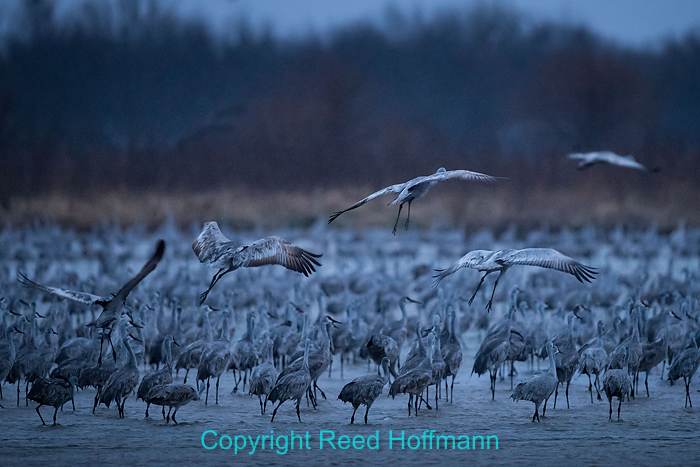
As darkness fell, the cranes returned to the river for a night’s rest. Nikon D5, ISO 12,800, 1/320 at f/4 in Aperture Priority, 0.0 EV, Nikkor VR 500mm f/4G IF-ED lens at 500mm. Photo copyright Reed Hoffmann.
By 8:30pm they were mostly done, and it was getting too dark to make pictures. Closing the windows, we began to settle in for the night. That meant rearranging the small space to fit our pads and sleeping bags. We had two small red-lensed flashlights they’d given us to help with that. You’re not allowed to use white lights in the blind, to keep from spooking the birds (the same reason you can’t go outside or extend lenses beyond the windows). By 9:30 we were lights out, and zipped into our bags listening to the wind and constant honking. It’s pretty amazing how loud that can be. We awoke at one point in the night by a noise that sounded like a tornado, only to realize something had scared the birds so they’d taken off, honking and flapping over the blind. The noise was so loud we had a hard time talking over it.
Rising at 6:30am, we bundled up against the morning cold and got our camera gear ready. Still heavily overcast, I started with the Nikon D5, with the ISO as high as 16,000, to maintain a shutter speed of 1/800 second with the 500mm lens wide open at f/4. By 8am the light had brightened to the point where I could shoot in the 800 ISO range and had also switched back to the D500. Until then, cranes would occasionally lift off in small groups and fly away. Around 8:15am, as if by a signal, they all took off. A few minutes later, there were none left in the water, as they’d returned to the fields. Shortly after that a staff member on came to collect us and our belongings.
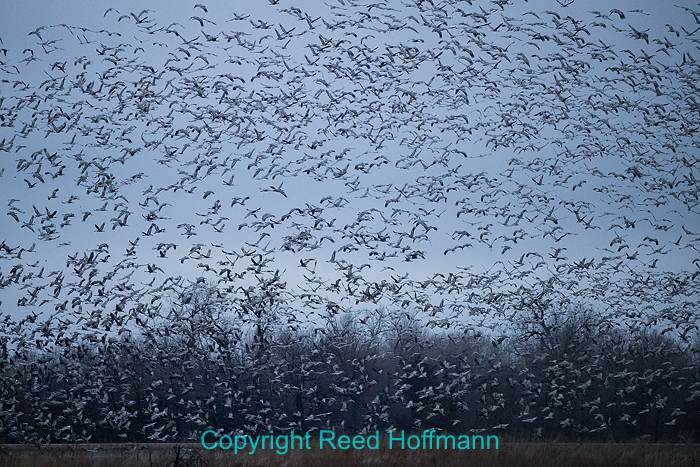
Rested from the night, the cranes left the river’s shore to spend the day feeding in the surrounding fields. Nikon D5, ISO 11,400, 1/800 at f/4 in Aperture Priority, +0.3 EV, Nikkor 500mm f/4 lens at 500mm. Photo copyright Reed Hoffmann.
Back at the main visitor center, we met up with the other two in our group. They’d spent the night warm and dry in a hotel room, and came back at 6am for the “General Crane Tour.” The fee for that was $10, and they were led as a group to one of the large viewing blinds along the river. Not designed as a photo tour, you can’t bring a tripod (monopods are okay) or fire continuous bursts with your cameras. If you want to do that, there’s also a “Photographers Crane Tour.” It costs $40, but was sold out. There’s also an evening photo blind tour, again $40, which lasts from 6pm until the dark. It too, was sold out, or we likely would have done that instead of spending the night in the blind. A warm, comfy bed in a hotel room would have been nice. But then again, we’d miss the whole toilet-bucket experience…
After rejoining our friends, we spent the next two hours driving the back roads around the river. That turned out to be the best way to get good close-ups of the cranes. In addition to picking through the leftover corn there was action – landing, jumping at each other, tossing corncobs and taking off. Quite honestly, those photos from the fields were better than anything we got along the river. But the river shots helped show the huge numbers of cranes, so were still an important part of the story.
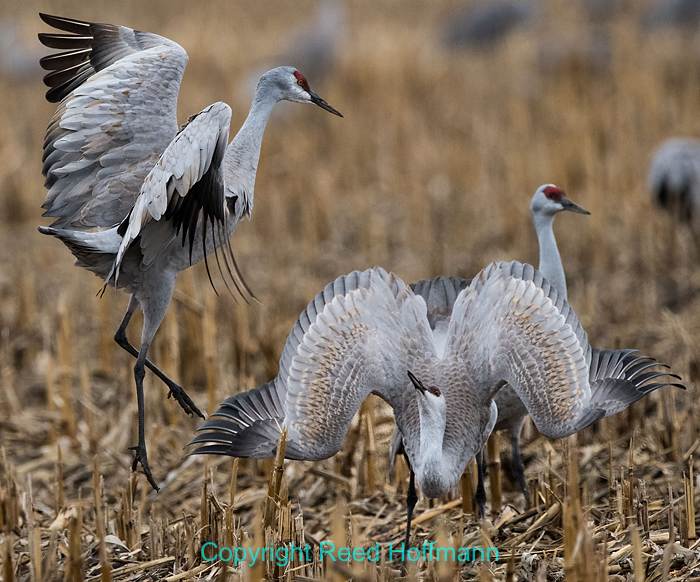
A pair of Sandhill Cranes putting on a show, jumping and posturing while in the fields. Those fields provided our best close-up photos of the birds. Nikon D500, ISO 2000, 1/2000 at f/5.6 in Aperture Priority, 0.0 EV, Nikkor VR 500mm f/4G lens with TC14 (1.4X) teleconverter for an equivalent of 1050mm. Photo copyright Reed Hoffmann.
On the way back to Kansas City, we made a short stop at Loess Bluffs National Wildlife refuge. Formerly called Squaw Creek, it’s about an hour and a half north of Kansas City, near St. Joseph. Mostly wetlands, it’s another area popular with birds, and a good stop for those migrating During our drive through we stopped to photography pelicans, hawks, heron, eagles and a few others. It was a nice ending to our little adventure.
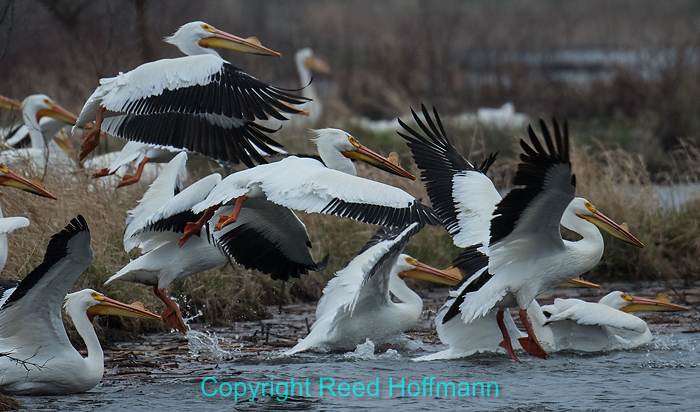
A group of American White Pelicans taking flight at Loess Bluffs National Wildlife Refuge. Nikon D500, ISO 1000, 1/1000 at f/5.6 in Aperture Priority, 0.0 EV, Nikkor VR Zoom 80-400mm f/4.5-5.6 lens at 400mm, for an equivalent of 600mm. Photo copyright Reed Hoffmann.
Looking back, I’m disappointed it took me so long to get around to doing this. We photographers are always looking for exotic places to make pictures, and sometimes forget about locations or events closer to us. That’s one reason I’m starting to research and visit more local spots, and planning more shooting workshops at Kansas City area locations. In late May I’m teaching a one-day session at Powell Gardens, and will try to put together a birding trip next spring to these spots in southern Nebraska. If you have interest in either of those, let me know. In the meantime, get out and explore your area. I’m sure you’ll find some exceptional photo ops!
(If you like this story, please share it with your friends, and also let them know about the links about photography I post on my business Facebook page. I’m also on Instagram and Twitter, @reedhoffmann)

